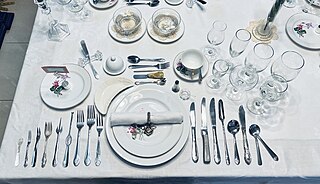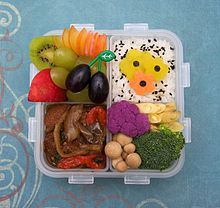
French cuisine is the cooking traditions and practices from France. In the 14th century, Guillaume Tirel, a court chef known as "Taillevent", wrote Le Viandier, one of the earliest recipe collections of medieval France. In the 17th century, chefs François Pierre La Varenne and Marie-Antoine Carême spearheaded movements that shifted French cooking away from its foreign influences and developed France's own indigenous style.

Japanese cuisine encompasses the regional and traditional foods of Japan, which have developed through centuries of political, economic, and social changes. The traditional cuisine of Japan is based on rice with miso soup and other dishes with an emphasis on seasonal ingredients. Side dishes often consist of fish, pickled vegetables, and vegetables cooked in broth. Common seafood is often grilled, but it is also sometimes served raw as sashimi or as sushi. Seafood and vegetables are also deep-fried in a light batter, as tempura. Apart from rice, a staple includes noodles, such as soba and udon. Japan also has many simmered dishes, such as fish products in broth called oden, or beef in sukiyaki and nikujaga.
An hors d'oeuvre, appetiser or starter is a small dish served before a meal in European cuisine. Some hors d'oeuvres are served cold, others hot. Hors d'oeuvres may be served at the dinner table as a part of the meal, or they may be served before seating, such as at a reception or cocktail party. Formerly, hors d'oeuvres were also served between courses. There are two types of hors d'oeuvre from service point of view:
- General hors d'oeuvre
- Classical hors d'oeuvre

Falafel is a deep-fried ball or patty-shaped fritter of Egyptian origin, featuring in Middle Eastern cuisine, particularly Levantine cuisines, and is made from broad beans, ground chickpeas, or both.

Roux is a mixture of flour and fat cooked together and used to thicken sauces. Roux is typically made from equal parts of flour and fat by weight. The flour is added to the melted fat or oil on the stove top, blended until smooth, and cooked to the desired level of brownness. A roux can be white, blond (darker) or brown. Butter, bacon drippings or lard are commonly used fats. Roux is used as a thickening agent for gravy, sauces, soups and stews. It provides the base for a dish, and other ingredients are added after the roux is complete.

A full-course dinner is a meal with multiple courses, almost invariably eaten in the evening or afternoon. Most Western-world multicourse meals follow a standard sequence, influenced by traditional French haute cuisine. It commonly begins with an appetizer, followed by the main course, the salad course, and eventually the dessert, but the exact sequence varies widely. Full-course dinners are generally very formal as well as very expensive, and can have as few as 3 or as many as 21 courses. Some major styles include service à la russe and service à la française.

Maqluba is a traditional Levantine dish that is popular across the Levant including in Palestine, Jordan, Syria, Lebanon, and Iraq.

Chinese aristocrat cuisine traces its origin to the Ming and Qing dynasties when imperial officials stationed in Beijing brought their private chefs and such different varieties of culinary styles mixed and developed over time to form a unique breed of its own, and thus the Chinese aristocrat cuisine is often called private cuisine. The current Chinese aristocrat cuisine is a mixture of Shandong cuisine, Huaiyang cuisine and Cantonese cuisine. As Beijing was the capital of the last three Chinese dynasties, most of the Chinese aristocrat cuisine originated in Beijing. Currently, there are a total of nine varieties of Chinese aristocrat cuisine.

Uzbek cuisine shares the culinary traditions of peoples across Central Asia. There is a great deal of grain farming in Uzbekistan, so breads and noodles are of importance, and Uzbek cuisine has been characterized as "noodle-rich". Mutton is a popular variety of meat due to the abundance of sheep in the country and it is a part of various Uzbek dishes.

Pasta salad is a salad dish prepared with one or more types of pasta, almost always chilled, and most often tossed in a vinegar, oil, or mayonnaise-based dressing. It is typically served as an appetizer, side dish or a main course. Pasta salad is often regarded as a spring or summertime meal, but it can be served any time of year.

The term Manchu–Han Imperial Feast refers to a style of cooking and a type of grand banquet that combines elements of Manchu and Han's Chinese cuisine developed in the Qing dynasty of China (1644–1912). The origins are disputed, but by the nineteenth century, the style became popular and was emulated in twentieth and twenty-first-century restaurants.

Clams casino is a clam "on the halfshell" dish with breadcrumbs and bacon. Green peppers are also a common ingredient.

Italian meal structure is typical of the European Mediterranean region and differs from Northern, Central, and Eastern European meal structure, though it still often consists of breakfast (colazione), lunch (pranzo), and supper (cena). However, much less emphasis is placed on breakfast, and breakfast itself is often skipped or involves lighter meal portions than are seen in non-Mediterranean Western countries. Late-morning and mid-afternoon snacks, called merenda, are also often included in this meal structure.

Pigeon pie is a savoury game pie made of pigeon meat and various other ingredients traditional to French cuisine and present in other European cuisines. It has been eaten at least as early as 1670 in French cuisine.

Erez Komarovsky is an Israeli chef, baker, educator, and author. In the 1990s he founded the Lehem Erez bakery and café chain, and he is considered the initiator of artisanal bread-making in Israel. Since 2007 he has led a cooking school in his home in Mitzpe Mattat in the Upper Galilee. He has authored several cookbooks.

Kashk bademjan, alternatively kashk-e bademjan or Kashk o bademjan, is a staple Iranian dish made with "kashk and eggplant" – also the literal translation of its Persian language name. The dish is served as a dip and typically garnished with liquid saffron, sautéed onions, garlic and often walnuts. It can be consumed either as an appetizer or a main dish, and is typically eaten with fresh bread.

Utica greens is an Italian American dish made of escarole sauteed with garlic and olive oil. Most recipes include hot cherry peppers, pecorino cheese, bread crumbs, prosciutto or another cured meat, and sometimes chicken broth. In the 1980s, Italian restaurants in Utica began serving this variation on traditional Sicilian and Southern Italian sauteed greens; the dish has since spread to other cities in the United States. Other variations include greens with potatoes, romaine, kale, Swiss chard, and pignoli nuts.
Niki Nakayama is an American chef and the owner of Michelin-starred n/naka restaurant in Los Angeles, specializing in modern Japanese kaiseki cuisine.

Kaiseki (懐石) or kaiseki-ryōri is a traditional multi-course Japanese dinner. The term also refers to the collection of skills and techniques that allow the preparation of such meals and is analogous to Western haute cuisine.




























